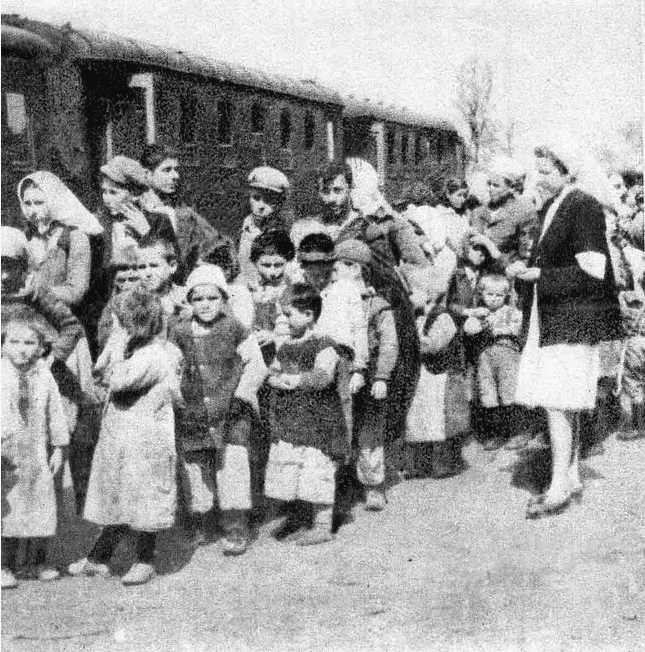Howard Fischer
Uppsala, Sweden
 |
|
Child refugees from Macedonia, Greece, 1948. Retouched from the original held by the State Archives of the Republic of Macedonia (DARM). Via Wikimedia. No known restrictions on publication or modification. |
“He’s only a pawn in their game.”1
– Bob Dylan
Between 1950 and 1962, 3,200 Greek children were adopted by American couples. The Greek Civil War (1946–1949) had begun after Nazi occupation of Greece ended. Western countries supported the Greek government against the communist rebels.2 After so many years of war, there were orphans in Greece.
The first wave of orphans, from 1950 to the summer of 1953, consisted mainly of older boys up to fourteen years old who were going to the US to live with relatives.3 In 1953, the US government passed the Refugee Relief Act, also known as the Emergency Migration Act. More orphans were allowed into the US, as well as more relatives of American citizens. The second wave of Greek orphans started in 1954 and went on through 1962. These were infants and children up to four years old. However, sadly, not all of these children were orphans or willingly placed for adoption. Some of them were children of Greek communists and unwed mothers. The policy of the Greek government was similar to the forced adoptions in Francoist Spain,4 except that in Greece the children were sent overseas.
The post-war US was in the midst of a “baby boom.” Having children was normal and expected, and for childless couples, adoption was a path to parenthood.5 Some children went to Greek-American families; others did not. These adoptions were arranged through Greek lawyers. Adoptive parents did not need to go to Greece to see the children, nor to be screened for suitability. Often, prospective adoptive parents in the US were shown a catalogue with photos of children and made their choice on that basis. Some of these adoptive parents had already been rejected by U.S. adoption agencies. The lawyers charged $500 per adoption in 1955 and $3000 in 1957. Adoptive parents were assured that if they were “not satisfied” with the infant, either because of the “child’s illness or quarrels with siblings,” they could just “give the baby back.”6
The American Hellenic Educational Progressive Association (AHEPA), a fraternal organization founded in 1922 to protect Greek Americans from the Ku Klux Klan, tried to manage and supervise the adoption of Greek children. Unfortunately, in 1957 AHEPA ceded supervision to a number of Greek and Greek-American lawyers, and a baby “black market” began. The sale of babies to the US was very profitable.7 In addition, the Greek government wanted to show its cooperation with the US, which had announced the Truman Doctrine (1947), a plan to financially support democracies in combatting communism, during the Greek Civil War. In 1948 the Marshall Plan, designed to help European economies recover from World War Two, earmarked $376 million (equivalent to over $3 billion today) for Greece.8 If the exchange of Greek babies was needed to keep US cash flowing, it was a price Greece paid during the Cold War.
These babies were white and adopted by upper- and middle-class white families. Jewish families also thought that these children would blend in with other family members.9 Facilitating adoptions was big business. Corrupt and cruel practices were sometimes used to obtain infants. Mothers who delivered twins might be told that that only one baby survived, and the other died. The “dead” twin was not dead at all, but sold to adoption arrangers.10 This same deception was also used in fascist Spain.11 Few or no records were kept in Greece of these illegal adoptions. Adoptive parents “insisted that the American doctor associated with the US embassy do the health check.” Some paid lawyers to find a doctor to do an additional examination. The doctors at orphanages had to sign off on the health of a child; otherwise, no visa would be given.12
Between 1960 and 1975, 600 Greek children were also adopted by couples in the Netherlands. However, once the illegal practices in the Greek adoption system became known, the Dutch adoptions stopped. A small number of Greek children were also adopted in Sweden.13
References
- Bob Dylan. “Only a Pawn in Their Game.” The Times They are A-Changin’. Warner Brothers, 1963.
- Krystalli Glyniadaki. “The constant detective,” Agenda Magasin, 9 Nov 2019. https://agendamagasin.no/artikler/the-constant-detective/.
- Gonda Van Steen. “Greek Children of the Silent Migration: The AHEPA’s Role in the US Adoptions from Greece in the 1950s-1960s.” The 2021 AHEPA Golden Gate District Lecture Series, 2021. https://youtube.com/watch?v=s6H7LpF3GfM.
- Andrei Talpaga. “Between 1939 and 1989 over 300,000 newborns were sold in Spain,” History of Yesterday, 2012.
- Van Steen, “Silent Migration.”
- Kelly Fanarioti. “The tragedy with the 4000 Greek children who were sent to the USA during the cold war (1950s-1960s),” Neo Magazine, 22 March 2022. https://neomagazine.com/2022/03/the-tragedy-with-the-4000-greek-children-who-were-sent-to-the-usa-during-the-cold-war-1950s-1960s/.
- Van Steen, “Silent Migration.”
- “Marshall Plan.” Wikipedia.
- Glyniadaki. “Detective.”
- Glyniadaki. “Detective.”
- Spain’s Stolen Babies, reported and produced by Katya Adler. BBC This World, 2012.
- Gonda Van Steen, conversations with author, 24 September and 4 October, 2022.
- Van Steen, “Silent Migration.”
HOWARD FISCHER, M.D., was a professor of pediatrics at Wayne State University School of Medicine, Detroit, Michigan.
Fall 2022 | Sections | History Essays

Leave a Reply